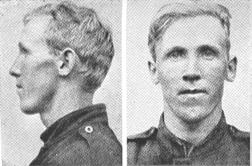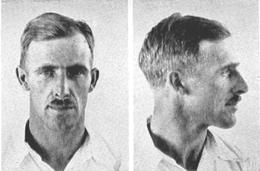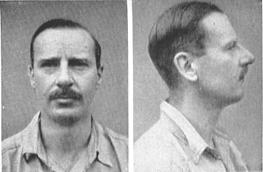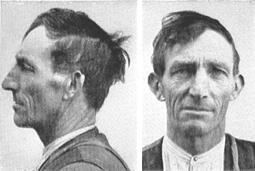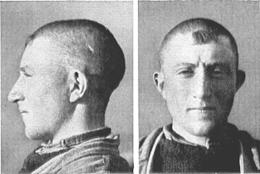|
(Photographic Supplement, Plate 29)
Keltic Iron Age Types FIG. 1 (2 views, Bryn and Schreiner, Somatologie der Norweger, Table 27, Fig. 81). A Norwegian from Drangedal of standard, Eastern Valley type as specified in Chapter 9, section 4. This is the type associated with the Hallstatt Iron Age remains in central Europe, and which probably did not enter Scandinavia much before the middle of the first millennium B.C. It has since been largely replaced in central Europe, but has found a refuge in Sweden and in the eastern valleys of southern Norway.
FIG. 2 (2 views). An Englishman from the neighborhood of London, who belongs to exactly the same central Nordic type. In England this type is largely of Anglo-Saxon and Danish inspiration.
FIG. 3 (2 views). An East Anglian from Ipswich, Suffolk. More of the English belong to this locally older Keltic Iron Age type, which came from southwestern Germany with the Kelts and is differentiated by a lower cranial vault, a more sloping forehead, and greater nasal prominence. The hair color is more frequently brown than light blond.
FIG. 4 (2 views, photo C. W. Dupertuis). The Iron Age Nordic type is particularly important in Ireland, which was never strongly invaded by Germanic-speaking Hallstatt Nordics. This individual, a man from County Clare, with his sloping forehead, aquiline nose, and brown hair, is an excellent example.
FIG. 5 (2 views, photo C. W. Dupertuis). A special population, largely the product of isolation, has developed in the Aran Isles. Here a local Nordic type of great vault length and exceptionally low vault height, great facial and nasal length, and an excess of blue eyes and golden and red hair, has developed. The young man shown in this figure is an excellent example of this type.
FIG. 6 (2 views, photo C. W. Dupertuis). The Aran Islander shown in this figure is relatively brunet for his group, and has the exceptionally low auricular head height of 110 mm. He illustrates the principle that the low-headed factor is borne by the least blond element in the Aran population. Note the convergent temporal planes and the cylindrical profile of the vault when seen in the front view. This feature, in less exaggerated form,.is a cranial diagnostic of the Keltic Iron Age type in general.
|
